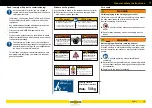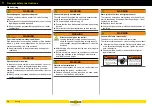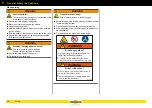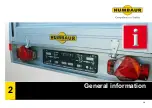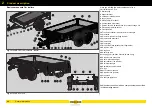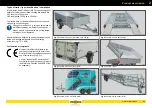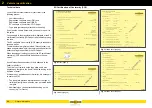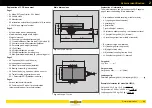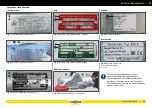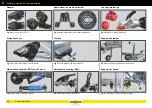
1
Check, adjust and secure before each journey
11
Safety
Sources of danger
It is absolutely essential to comply with the following points:
–
Coupling and uncoupling the trailer - prohibited to stand in
the danger zone
–
Loading and unloading the trailer - prohibited to stand in the
danger zone
–
Driving with unsecured support devices
–
Driving with unlocked drop sides / doors / flaps / ramp walls
–
Clearance heights on the route, while loading and
unloading
–
Exceeding the permissible gross weight or one-sided over-
loading through incorrect loading
–
Poorly secured or unsecured goods and / or body compo-
nents
–
Reversing - keep an eye on the area behind the trailer
–
Excessive turning when manoeuvring e.g. on turntable
trailers
–
Overloading the trailer, axles and brakes
–
Overstressing caused by fitting incorrect wheel and tyre
sizes
–
Use of wheels with incorrect offsets, one-sided run-out or
centrifugal imbalance
–
Overstressing as a result of reckless and inappropriate
driving or handling
–
Impact and shock stress of the axles
–
Speed inappropriate for the road conditions and the loading
status of the trailer, especially around bends
–
The parked trailer can roll away, tip or sink in on soft,
uneven ground
–
Non-compliance with the conditions for driving with 100 km/
h permit
–
Driving on terrain with steep inclines
–
Loading / unloading of the trailer in an area with a steep
gradient
–
Inadequate cleaning of the cargo bed after every use
For trailers which can be tipped / lowered
–
Standing under an unsecured cargo bed
–
Jerky braking during tipping / lowering process
–
Driving with a tipped / raised cargo bed
–
Tipping the cargo bed without adequately observing the
area at the rear / side
–
Tipping out the load too close to a slope or excavation pit
–
Standing on a tipped / moving cargo bed
–
Tipping the cargo bed on uneven, soft ground
–
Tipping viscous load materials e.g. asphalt, soil, loamy
sand
–
Tipping large rocks
–
Tipping with an inclined combination
–
Driving vehicles onto the cargo bed without paying
attention to the centre of gravity of the vehicle driving on
In the body area
Close and secure all body components, such as:
–
Drop sides
–
Tailgate / ramp door
–
Doors / flaps
–
Cover net / tarpaulin
–
Toolbox
–
Access ladder / folding step
–
Ensure that the load distribution is balanced / even
In the chassis area
Note the following in general:
–
Lock the coupling properly
–
Check that the ball head coupling and the ball head
coupling are not damaged
–
Establish the electrical connections
–
Check the trailer lights, repair faulty lights
–
Retract the support devices and lock them
–
Check the tyres and rims for damage
–
Check the tyre pressure, including the spare wheel
–
Check the tightening torque of the wheel nuts
–
In the case of a new trailer, re-tighten the wheel nuts
after 50 km and after the first journey with a load
–
Secure the: spare wheel / spare wheel holder, wheel
chock
–
Comply with the permissible gross weight
–
Check that all plates and stickers are present and clean
Summary of Contents for 1000 Series
Page 1: ...GENERAL CAR Program PART 1 OPERATING MANUAL humbaur com 1000 8400 SERIES EN ...
Page 9: ...1 7 Safety ...
Page 21: ...2 19 General information ...
Page 31: ...3 29 Operation ...
Page 67: ...3 65 Operation Trailer safety ...
Page 75: ...4 73 Chassis ...
Page 103: ...5 101 Body ...
Page 134: ...Cover net 5 132 Body ...
Page 135: ...6 133 Electrical system ...
Page 145: ...7 143 Testing care and maintenance ...
Page 185: ...8 183 Troubleshooting guide ...
Page 194: ...Hydraulics 8 192 Troubleshooting guide ...
Page 195: ...9 193 Proof of inspection ...

















